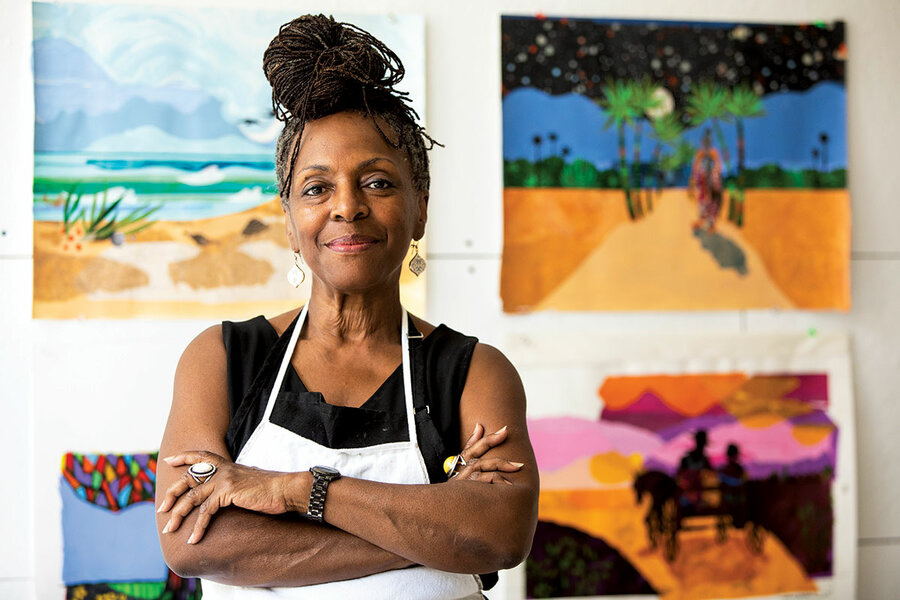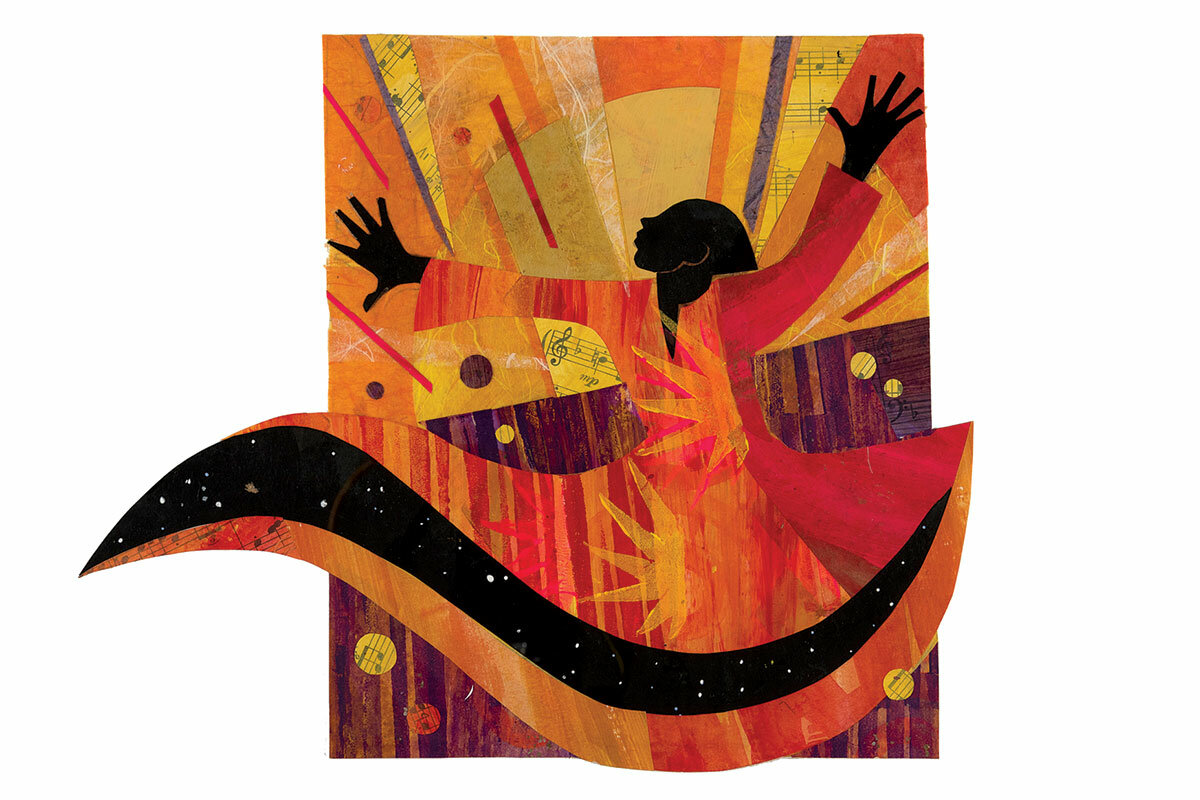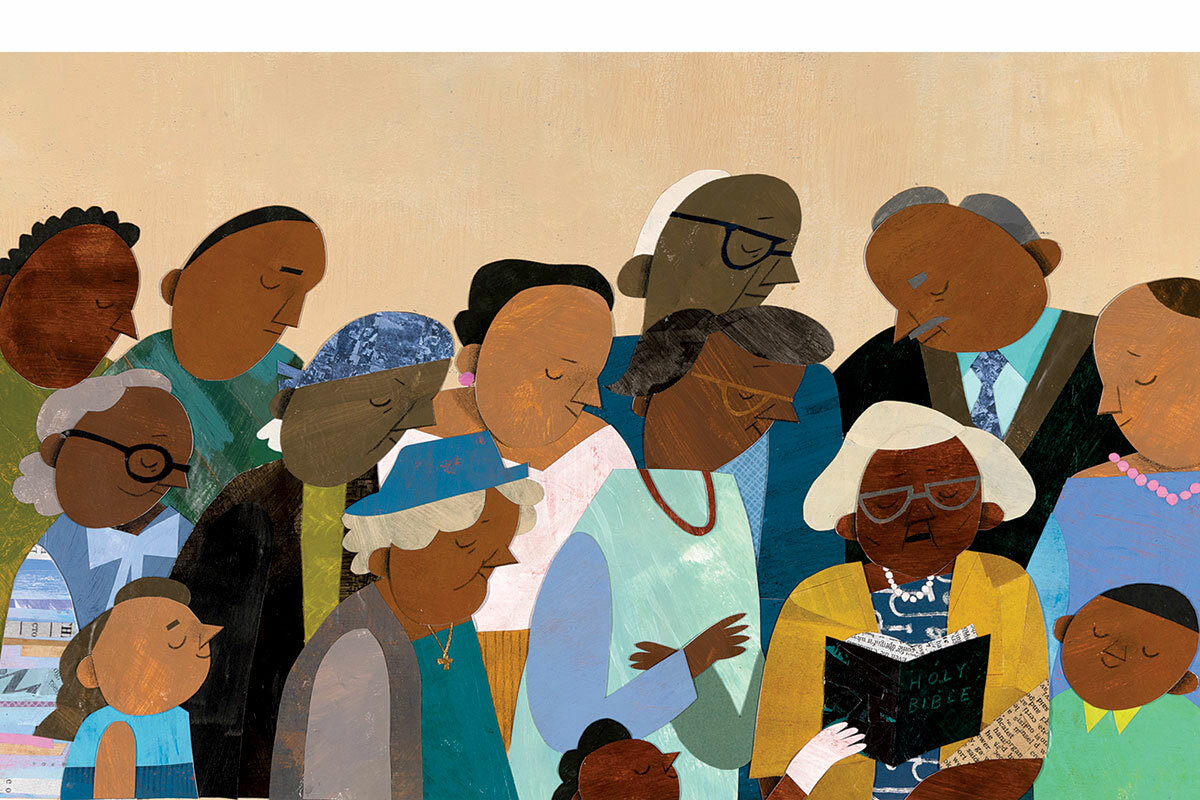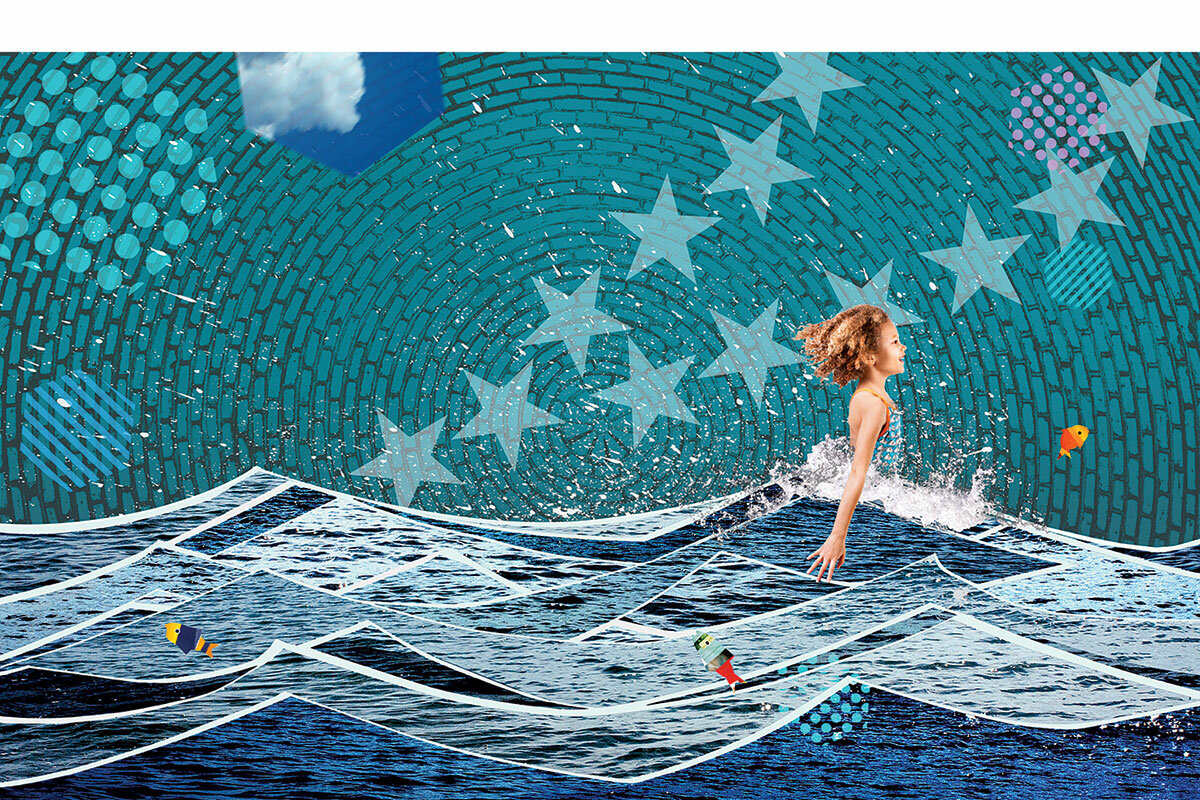Collage artists layer meaning and delight
Loading...
| Boston and Amherst, Mass.
Anyone who’s picked up a picture book by Eric Carle, from “The Very Hungry Caterpillar” to “A House for Hermit Crab,” instantly recognizes the vivid illustrations, which were assembled from layers upon layers of tissue paper. The late Mr. Carle’s collages inspire artists today to expand on his legacy, and to experiment with imagery from their own backgrounds and cultural traditions.
Ekua Holmes, a Boston-based artist whose work appears in a current exhibition at The Eric Carle Museum of Picture Book Art in Amherst, Massachusetts, has described collage as a kind of alchemy. “In its own small way, collage is recycling, upcycling, revitalizing items that already had a life. And I love that aspect. Because it already belonged to someone. And it brings that energy into a work of art.”
Showcasing the vitality and diversity of the art form is central to the exhibition, says Ellen Keiter, the Carle’s chief curator. “We wanted a balance, we wanted different generations of artists who worked in collage.” On the walls, art from classic stories like “The Very Hungry Caterpillar” and Ezra Jack Keats’ 1962 “The Snowy Day” is juxtaposed with work by contemporary picture book artists.
The practice of creative recycling plays a prominent role in collage – as both metaphor and technique.
Most people are familiar with the concept of collage, which can involve scraps of paper, pictures, cloth, or even small objects rearranged to form something new.
“We all need examples of [making] success out of chaos in a fragmented world,” says Nina Maurer, guest curator of the recent exhibition “Imagine That! The Power of Picture Books” at the Portsmouth Historical Society in Portsmouth, New Hampshire. “So if we look to worlds built with fragments of paper and other materials to make sense of our experience there’s a kind of joy in recognizing ... what collage can bring to us.”
Oge Mora, another artist featured in the Carle exhibition, says she was always drawn to colors and patterns, but she often found herself as a young artist getting caught up in ideas about what art is “supposed to look like.”
“What does it mean for us as people, if we can look at the things that are around us all the time, the things that we overlook, or things we might throw away, and you can find something beautiful about them?” asks Ms. Mora.
“Collage is all about how you want to express yourself, and what you want to say, so it’s a real rebel medium,” she says.
In her experience, that rebellion has largely been based in her culture as a Black American. During college, Ms. Mora had to learn to trust herself and question the artistic spaces around her, as well as the motives of the gatekeepers who decided what was included and what wasn’t.
Collage as rebellion
Acts of resistance also largely informed Mr. Carle’s work, says Ms. Maurer, the curator. “Carle was rebelling against what he experienced as a child in Nazi Germany. He said that it was the impression of those gray walls and the lack of color in his world that he fought to counter in his career as an artist.”
Although he’s now famous for his cheerful picture books bursting with color, Mr. Carle’s childhood was anything but. His family moved from Syracuse, New York, to his father’s hometown of Stuttgart, Germany, when he was 6, just before the start of World War II.
The move thrust Mr. Carle into the rigid, colorless, and sometimes physically abusive Nazi school system. He found refuge in his high school art classes, where he was encouraged by a brave teacher to pursue the loose shapes and forms of abstract art, which was forbidden by the Nazis. Art became a means of escaping his dismal surroundings.
Mr. Carle moved back to the United States as a young adult in 1952. By the time of his death in 2021, he had illustrated more than 70 books, most of which he also wrote.
Rising above adversity
On closer look, the story of collage is also one of ingenuity – overcoming adversity by finding beauty and self-expression in things cast aside. The centuries-old traditions of African American quilt-making have an improvisational quality that reminds many people of collage. While the quilts served a utilitarian purpose, reusing scraps of fabric and keeping out the cold, they also showcased their makers’ personalities and artistry.
Ms. Mora says she was drawn to the “language and aesthetic” of collage as she was looking for her artistic voice. She says she was not only inspired by African textile traditions but also by contemporary African Americans working in three-dimensional media, such as Aminah Robinson, an artist from Ms. Mora’s hometown of Columbus, Ohio, who created tapestry-like quilts from recycled objects like old jeans and lost buttons.
“I always really gravitated towards her work from a very young age,” says Ms. Mora, who is now based in Providence, Rhode Island.
She adds that Ms. Robinson’s work taught her to see what could be made out of unconventional objects or materials. She regularly thumbs through old books for inspiration.
“Papers and stuff that are commonplace, when you put them on the page, suddenly they’re profound,” she says.
Children’s books and collage
Collage was popularized in children’s books in the 1960s by Mr. Carle and Mr. Keats. It’s an approach that had the potential to appeal beyond the target audience.
“[Collage has] an immediate attraction for young children because they recognize it as a bridge to them. ... It’s got color. It’s got bold shapes. ... It’s got a surprise with the turn of one page to the next,” says Ms. Maurer. “That pleasure of discovery,” she says, “is universal and does not fade.”
“We have incredible nostalgia and memories tied to picture books as adults, but as children, we are engaging and learning things from them,” says Ms. Keiter, the Carle curator.
“The Very Hungry Caterpillar,” for example, has sold over 50 million copies and has been translated into more than 60 languages since 1969. Its success and that of Mr. Carle’s other titles, along with a desire to raise the profile of children’s book art, led the artist and his wife to open the museum that bears his name in 2002.
“Celebrating Collage: A 20th Anniversary Exhibition,” which continues through Dec. 31, includes the work of 20 picture book collage artists, including Ms. Mora and Ms. Holmes – who continues to be impressed by the accessibility of the medium.
“One of the things I love about collage ... is that it’s very democratic; it’s very grassroots,” Ms. Holmes says. “Whatever you have on hand you can work with. I think that’s a perfect message for our time, because in many aspects of life right now we’re getting lemons, so we need to be making lemonade.”









